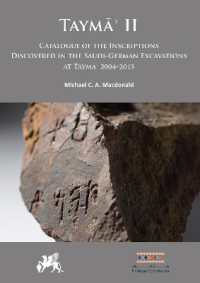Full Description
Long shrouded in secrecy, alchemy is now recognized as the ancestor of modern chemistry.
Before the advent of modern science, alchemy was the ancient art of transformation, a way of combining matter to create a divine force. Today alchemy retains a strong pull on the imagination, with its tales of turning base metals into gold and mixing potions to create the elixir of life, a draught that brings immortality.
Alchemy Illustrated offers a vivid illustrated guide to this lost art, introducing the reader to the main developments in alchemy and the most famous people to have dabbled in this speculative science.
Discover the alchemical elements and their properties, a precursor to the periodic table, which included such substances such as bismuth, sulfur and moon-silver, the last of these symbolizing intuition, resurrection and illumination; learn about the Philosopher's Stone, a mythic alchemical substance capable of turning base metals into gold, and pursued by famous scientists such as Isaac Newton, who wrote more than a million words on alchemy during his lifetime; and encounter Hennig Brand, who in 1669 accidentally discovered the chemical element phosphorus during alchemical experimentation.
Beautifully produced in traditional Chinese binding, Alchemy Illustrated introduces the reader to the history of alchemy, its practice, symbols and famous alchemists through the ages.
Contents
Contents
1: Introduction The art of alchemy was handed down through the centuries from Egypt and Arabia to Greece and Rome, and finally to western and central Europe. Simplified, the aims of the alchemists were threefold: to find the Stone of Knowledge (The Philosophers' Stone), to discover the medium of Eternal Youth and Health, and to discover the transmutation of metals.
2: Alchemical Elements In the early days of alchemy, the astronomical signs of the planets were also used as alchemical symbols. Then in the centuries of medieval persecution and suppression every alchemist invented his own secret symbols. Charlatans, quacks and cheats took over and alchemy became, along with sorcery and witchcraft, infamous for fraud and extortion. In the 18th century scientists tried to pry loose the real achievements in chemistry, pharmacology and medicine from this confusing cornucopia of science and magic.
3: The Philosopher's Stone and the Elexir of Life In Alchemy the substances used are broken down into a state of chaos, from which a miraculous physical substance emerges that can produce magical results. Alchemists were notorious for attempting to make synthetic gold, but their goals were far more ambitious: to transform and bend nature to the will of an industrious human imagination. For scientists, philosophers and artists alike, alchemy seemed to hold the key to unlocking the secrets of creation. Alchemists' efforts to discover the way the world is made have had an enduring impact on artistic practice and expression around the globe. The Philosopher's Stone was capable of turning any 'base metal' into a so called 'noble metal', such as gold. In Western alchemy, it is an unknown substance, also called "the tincture" or "the powder," sought by alchemists for its supposed ability to transform base metals into precious ones, especially gold and silver. Alchemists also believed that an elixir of life could be derived from it. The Elixir of Life (elixir vitae) is a potion that grants the drinker an indefinitely extended life, for as long as they keep drinking it regularly, though, the frequency with which it needs to be consumed (along with its entire creation process) is unknown.
4: Great Alchemists Inventions born from alchemical laboratories include metal alloys for sculpture and ornament, oil paints, effects in glassmaking, and even the chemical baths of photography. Jabir ibn Hayyan - Known in Europe as Geber, this Islamic scholar of the Middle Ages is considered the father of alchemy and one of the founders or pioneers of pharmacology and modern chemistry. Paracelsus - The three primes, also known as the tria prima, were named by Paracelsus, a Swiss philosopher, in the 16th century. Trithemius (1462-1516) on his deathbed dictated a recipe that which he said would preserve mind, health, and memory with perfect sight and hearing, for those who made use of it. It consisted of, among other things, calomel, gentian, cinnamon, aniseed, nard, coral, tartar, and mace. Nicolas Flamel was a French scribe and manuscript seller. After his death, Flamel developed a reputation as an alchemist believed to have created and discovered the philosopher's stone and to have thereby achieved immortality. Isaac Newton - Newton believed that the so-called 'vegetation of metals' was evidence of mysterious forces in nature. Newton interpreted Greek myths as alchemical recipes. Hennig Brand - In 1669, Brand accidentally discovered the chemical element phosphorus while searching for the 'philosopher's stone'. Ge Hong - A Chinese alchemist who tried to combine traditional Confucian ethics with the occult doctrines of Daoism. Franz Seraph Tausend, 'Der Goldmacher', was a 20th-century German alchemist, who was able to raise significant funding from senior Nazi Party figures for his project.







